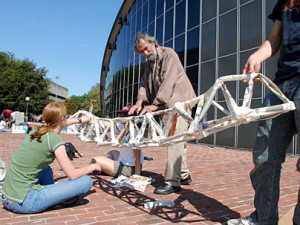(My alternative title to this post was going to be a music reference: “Bridge Over Troubled Waters.” But then, I thought the video link I posted below would be more fun.)
I found the applications of theories by classmates Daniel and Leslie to really expand the thinking I’ve done so far on my own OoS. In fact, building bridges between such operationalizing of network objects suggests they are not so different at all. Leslie’s comments on the hardware theory’s impact on her writing center space reminded me at some points of Daniel’s (as well as my own OoS of Composition MOOCs), especially with Leslie’s observations about ways data is transformed through back end and front end access points. Daniel’s treatment of Google Analytics is all about transformation of data, by the software as well as the hardware, and of course the human agents who apply the information thus gathered for future analysis and interrogation.
This passage in Leslie’s Case Study also reminded me of Popham’s article on “Forms as Boundary Genres,” in that the forms used by students and moved along the network system to different nodes / operators effectively transformed / were transformed by the localized exigency of the user and the activity. Given the nature of that movement, which Leslie points out resembles the serial / parallel bus structures of hardware theory, I could not help but think of the networks of a MOOC space, a thought I also had while reading Daniel’s Case Study. In my response to Daniel’s post, I wrote about his attention to Foucault’s “conditions of existence,” an idea that “seems [perfectly] suited to a discussion of the inner workings of a website, a “text” or locus of activity that for many readers conceals such rules and conditions.”
The connection between Daniel’s and Leslie’s thinking, then, emerged in this consideration of concealment or underlying structures that often go unrevealed, whether due to their existence as software / hardware “behind the scenes” movements or when they are considered from the perspective of agency. For example, what control (or creative agency) does the user of the websites Daniel discusses have upon the ways in which that data is used by those on the “back end” of the network’s framework? Similarly, Leslie’s observations about the latent hierarchies of power / oversight made me think of the user-design focus (could this be Spinuzzi creeping in?) and how the direction of information has the power to mediate the form or site of encounters.
There is so much potential application to my own OoS as a result of reading both Daniel’s and Leslie’s posts. I feel as though I’m going to need a bigger invention space than one Popplet will allow. Leslie, can I come and work on your studio white board space?
And now, the promised audio — not a bridge metaphor precisely, but attention-getting just the same.
http://www.youtube.com/watch?v=VeXBGN0RmwM


